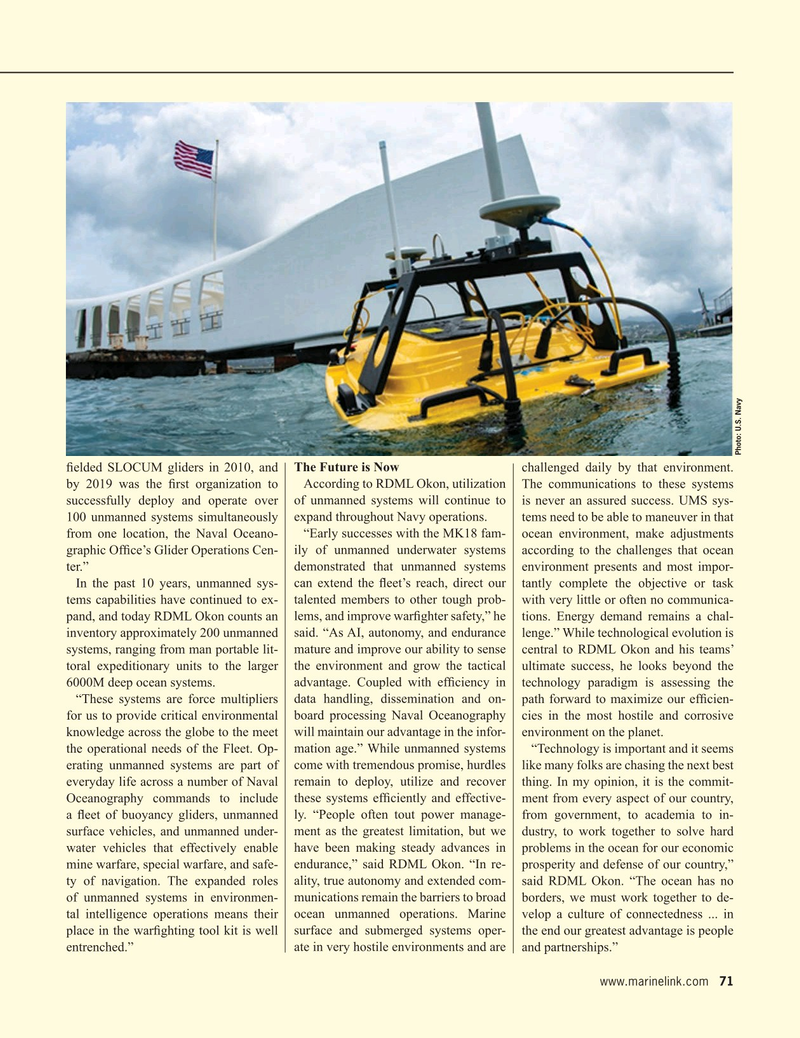
Page 71: of Maritime Reporter Magazine (November 2020)
Workboat Edition
Read this page in Pdf, Flash or Html5 edition of November 2020 Maritime Reporter Magazine
Photo: U.S. Navy ? elded SLOCUM gliders in 2010, and The Future is Now challenged daily by that environment. by 2019 was the ? rst organization to According to RDML Okon, utilization The communications to these systems successfully deploy and operate over of unmanned systems will continue to is never an assured success. UMS sys- 100 unmanned systems simultaneously expand throughout Navy operations. tems need to be able to maneuver in that from one location, the Naval Oceano- “Early successes with the MK18 fam- ocean environment, make adjustments graphic Of? ce’s Glider Operations Cen- ily of unmanned underwater systems according to the challenges that ocean ter.” demonstrated that unmanned systems environment presents and most impor-
In the past 10 years, unmanned sys- can extend the ? eet’s reach, direct our tantly complete the objective or task tems capabilities have continued to ex- talented members to other tough prob- with very little or often no communica- pand, and today RDML Okon counts an lems, and improve war? ghter safety,” he tions. Energy demand remains a chal- inventory approximately 200 unmanned said. “As AI, autonomy, and endurance lenge.” While technological evolution is systems, ranging from man portable lit- mature and improve our ability to sense central to RDML Okon and his teams’ toral expeditionary units to the larger the environment and grow the tactical ultimate success, he looks beyond the 6000M deep ocean systems. advantage. Coupled with ef? ciency in technology paradigm is assessing the “These systems are force multipliers data handling, dissemination and on- path forward to maximize our ef? cien- for us to provide critical environmental board processing Naval Oceanography cies in the most hostile and corrosive knowledge across the globe to the meet will maintain our advantage in the infor- environment on the planet.
the operational needs of the Fleet. Op- mation age.” While unmanned systems “Technology is important and it seems erating unmanned systems are part of come with tremendous promise, hurdles like many folks are chasing the next best everyday life across a number of Naval remain to deploy, utilize and recover thing. In my opinion, it is the commit-
Oceanography commands to include these systems ef? ciently and effective- ment from every aspect of our country, a ? eet of buoyancy gliders, unmanned ly. “People often tout power manage- from government, to academia to in- surface vehicles, and unmanned under- ment as the greatest limitation, but we dustry, to work together to solve hard water vehicles that effectively enable have been making steady advances in problems in the ocean for our economic mine warfare, special warfare, and safe- endurance,” said RDML Okon. “In re- prosperity and defense of our country,” ty of navigation. The expanded roles ality, true autonomy and extended com- said RDML Okon. “The ocean has no of unmanned systems in environmen- munications remain the barriers to broad borders, we must work together to de- tal intelligence operations means their ocean unmanned operations. Marine velop a culture of connectedness ... in place in the war? ghting tool kit is well surface and submerged systems oper- the end our greatest advantage is people entrenched.” ate in very hostile environments and are and partnerships.” www.marinelink.com 71
MR #11 (66-74).indd 71 11/9/2020 1:59:57 PM

 70
70

 72
72
